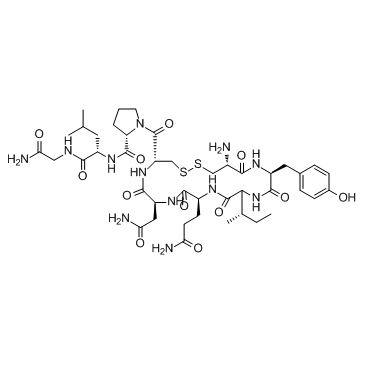Oxytocin acetate salt

Oxytocin acetate salt structure
|
Common Name | Oxytocin acetate salt | ||
|---|---|---|---|---|
| CAS Number | 50-56-6 | Molecular Weight | 1007.187 | |
| Density | 1.3±0.1 g/cm3 | Boiling Point | 1533.3±65.0 °C at 760 mmHg | |
| Molecular Formula | C43H66N12O12S2 | Melting Point | 192-194°C | |
| MSDS | Chinese USA | Flash Point | 881.1±34.3 °C | |
|
Divergent effects of oxytocin treatment of obese diabetic mice on adiposity and diabetes.
Endocrinology 155(11) , 4189-201, (2014) Oxytocin has been suggested as a novel therapeutic against obesity, because it induces weight loss and improves glucose tolerance in diet-induced obese rodents. A recent clinical pilot study confirmed the oxytocin-induced weight-reducing effect in obese nondi... |
|
|
Intracerebroventricular oxytocin administration in rats enhances object recognition and increases expression of neurotrophins, microtubule-associated protein 2, and synapsin I.
J. Neurosci. Res. 93(6) , 893-901, (2015) Brain oxytocin regulates a variety of social and affiliative behaviors and affects also learning and memory. However, mechanisms of its action at the level of neuronal circuits are not fully understood. The present study tests the hypothesis that molecular fa... |
|
|
The regulation of oxytocin receptor gene expression during adipogenesis.
J. Neuroendocrinol. 27(5) , 335-42, (2015) Although it has been reported that oxytocin stimulates lipolysis in adipocytes, changes in the expression of oxytocin receptor (OTR) mRNA in adipogenesis are still unknown. The present study aimed to investigate the expression of OTR mRNA during adipocyte dif... |
|
|
Asymmetric expression of connexins between luminal epithelial- and myoepithelial- cells is essential for contractile function of the mammary gland.
Dev. Biol. 399(1) , 15-26, (2015) Intercellular communication is essential for glandular functions and tissue homeostasis. Gap junctions couple cells homotypically and heterotypically and co-ordinate reciprocal responses between the different cell types. Connexins (Cxs) are the main mammalian... |
|
|
Social stress during lactation, depressed maternal care, and neuropeptidergic gene expression.
Behav. Pharmacol. 26 , 642-53, (2015) Depression and anxiety can be severely detrimental to the health of both the affected woman and her offspring. In a rodent model of postpartum depression and anxiety, chronic social stress exposure during lactation induces deficits in maternal care and increa... |
|
|
Oxytocin decreases sweet taste sensitivity in mice.
Physiol. Behav. 141 , 103-10, (2015) Oxytocin (OXT) suppresses food intake and lack of OXT leads to overconsumption of sucrose. Taste bud cells were recently discovered to express OXT-receptor. In the present study we tested whether administering OXT to wild-type mice affects their licking behav... |
|
|
Oxytocin facilitates the extinction of conditioned fear in humans.
Biol. Psychiatry 78 , 194-202, (2015) Current neurocircuitry models of anxiety disorders posit a lack of inhibitory tone in the amygdala during acquisition of Pavlovian fear responses and deficient encoding of extinction responses in amygdala-medial prefrontal cortex circuits. Competition between... |
|
|
Stability of peptide drugs in the colon.
Eur. J. Pharm. Sci. 78 , 31-6, (2015) This study was the first to investigate the colonic stability of 17 peptide molecules (insulin, calcitonin, glucagon, secretin, somatostatin, desmopressin, oxytocin, Arg-vasopressin, octreotide, ciclosporin, leuprolide, nafarelin, buserelin, histrelin, [D-Ser... |
|
|
Effects of atosiban on stress-related neuroendocrine factors.
J. Endocrinol. 225 , 9-17, (2015) Atosiban, an oxytocin/vasopressin receptor antagonist, is used to decrease preterm uterine activity. The risk of preterm delivery is undoubtedly associated with stress, but potential side effects of atosiban on neuroendocrine functions and stress-related path... |
|
|
Neuropeptide W-Induced Hypophagia is Mediated Through Corticotropin-Releasing Hormone-Containing Neurons.
J. Mol. Neurosci. 56 , 789-98, (2015) Neuropeptide W (NPW), which was originally isolated from the porcine hypothalamus, has been identified as the endogenous ligand for both the NPBWR1 (GPR7) and NPBWR2 (GPR8) receptors. These receptors, which belong to the orphan G protein-coupled receptor (GPC... |